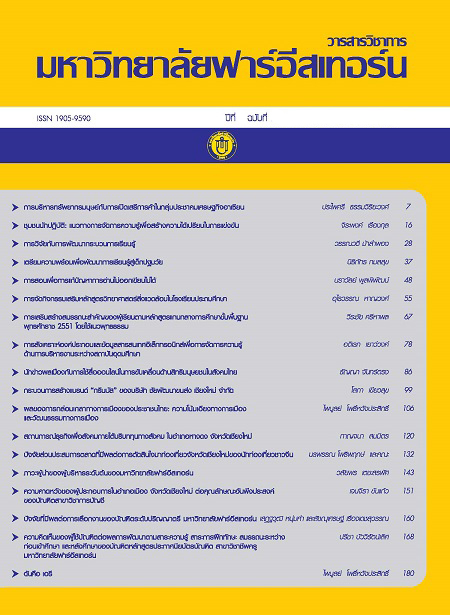การศึกษาปัจจัยที่ส่งผลต่อการตัดสินใจปลูกข้าวโพดบนพื้นที่สูง กรณีศึกษา ตำบลวาวี อำเภอแม่สรวย จังหวัดเชียงราย
Main Article Content
Abstract
โครงการวิจัยนี้มีวัตถุประสงค์เพื่อ ศึกษาปัจจัยที่ส่งผลต่อการตัดสินใจปลูกข้าวโพด และศึกษาความต้องการของเกษตรกรในการเลือกปลูกพืชชนิดอื่นแทนการปลูกข้าวโพด กลุ่มตัวอย่างที่ใช้วิจัย คือ กลุ่มเกษตรกรผู้ปลูกข้าวโพดในพื้นที่ตำบลวาวี อำเภอแม่สรวย จังหวัดเชียงราย จำนวนทั้งสิ้น 500 คน สถิติที่ใช้ได้แก่ สถิติเชิงพรรณนา ประกอบด้วย ค่าความถี่ ค่าร้อยละ ค่าเฉลี่ย และสถิติเชิงอนุมานได้แก่ ค่าสถิติ F-Test (One Way Anova) ผลการศึกษาพบว่าปัจจัยที่ส่งผลต่อการตัดสินใจปลูกข้าวโพด ในพื้นที่ตำบลวาวี อำเภอแม่สรวย จังหวัดเชียงราย ในภาพรวมพบว่า ปัจจัยลำดับแรกคือ ปัจจัยด้านชุมชน มีผลต่อการตัดสินใจปลูกข้าวโพดในระดับมาก รองลงมาคือ ปัจจัยด้านพื้นที่และสภาพแวดล้อม ปัจจัยด้านเครื่องมือ อุปกรณ์ เครื่องจักรกลสำหรับเพาะปลูกข้าวโพด ปัจจัยด้านผลผลิตและราคามีผลต่อการตัดสินใจปลูกข้าวโพดในระดับปานกลาง ขณะเดียวกันปัจจัยด้านแรงงาน ปัจจัยด้านต้นทุนการผลิต และปัจจัยด้านนโยบายรัฐมีผลต่อการตัดสินใจปลูกข้าวโพดในระดับน้อย นอกจากนี้ยังพบว่าเมื่อเปรียบเทียบปัจจัยที่ส่งผลต่อการตัดสินใจปลูกข้าวโพดพบว่าปัจจัยด้านแรงงานส่งผลต่อการตัดสินใจปลูกข้าวโพด อย่างมีนัยสำคัญทางสถิติที่ระดับ 0.05 ในด้านความต้องการที่จะปลูกพืชชนิดอื่นแทนการปลูกข้าวโพด พบว่าเกษตรกรส่วนใหญ่มีความต้องการที่จะปลูกพืชชนิดอื่นแทนการปลูกข้าวโพด โดยให้เหตุผลว่า การปลูกข้าวโพดในปัจจุบันมีต้นทุนในการปลูกเพิ่มสูงขึ้นทุกปี ราคาข้าวโพดในแต่ละปีการผลิตไม่แน่นอน และประสบปัญหาขาดทุนต่อเนื่องมาหลายปี โดยพืชที่เกษตรกรต้องการปลูกแทนการปลูกข้าวโพดลำดับแรกคือ ชา รองลงมาคือ ยางพารา และกาแฟ คิดเป็นร้อยละ 57.00, 29.00 และ 26.80 ตามลำดับ นอกจากนี้ยังพบว่าเกษตรกรส่วนใหญ่คิดเป็นร้อยละ 69.00 ยังคงต้องการให้รัฐบาลช่วยสนับสนุนกล้าพันธุ์พืชให้แก่เกษตรกร ดังนั้นในการแก้ไขปัญหาการบุกรุกพื้นที่ป่าเพื่อการปลูกข้าวโพดนั้นรัฐบาลจึงควรกำหนดให้เป็นพื้นที่ที่ปลูกข้าวโพดบนพื้นที่สูงเป็นพื้นที่พิเศษที่อนุญาตให้มีการปลูกพืชชนิดอื่นแทนข้าวโพดได้ โดยรัฐบาลควรมีการสนับสนุนกล้าพันธุ์ตามความต้องการของเกษตรกรและควรมีการให้ความรู้ทั้งด้านการผลิตและการตลาดให้แก่เกษตรกรด้วย
The objective of this project is to study on the factors that effect to the decision making in maize cultivation and to study on the need of the farmers in crop production selection to replace maize cultivation. The sample group that used in this research are the maize farmers in Wawee sub-district, Mae-Sruai district, Chiang Rai province. The total number of farmers in the study area is 500 people. The statistical analysis tools used in this research are Descriptive Statistics consists of frequency, percentage, average and Inferential Statistics which is F-Test (One Way Anova).The result of the study shows that the first factor that effect to the decision making is related to the community that has great influence to the decision making in maize plantation. Secondly, the factor that related to the area and environment. Thirdly, the factors related to the production tools, crop yield and cost have influence to the decision making in middle level and the last factors are related to the labor force, investing budget and government policy has less influence. It was found that, among the factors listed above, the only factor related to the labor force has noticeable influence in statistical meaning at level 0f 0.05 and the majority of the farmers need to plant other crops rather than maize, due to currently the investing cost has become higher yearly, the cost of the maize yield is not stable in each year and cause money loss continuously for many years. The crops that the farmers want to plant instead of maizeare tea, rubber and coffee which are 57.00%, 29.00 % and 26.80%, respectively. The results also show that 69.00% of the farmers still need support from the government for providing seeds. Therefore, in order to prevent illegal logging to forest area for agriculture activities, the government should define the agricultural area in hilly area which is allowed for agricultural activities of the local people to cultivate other crops instead of maize. The government should provide seeds by the need of the farmers, including production technique and marketing.
Article Details
1. Any views and comments in the Journal of Social Innovation and Lifelong Learning are the authors’ views. The editorial staff have not to agree with those views and it is not considered as the editorial’s responsibility.
2. The responsibility of content and draft check of each article belongs to each author. In case, there is any lawsuit about copyright infringement. It is considered as the authors’ sole responsibility.
3. The article copyright belonging to the authors and The Far Eastern University are copyrighted legally. Republication must be received direct permission from the authors and The Far Eastern University in written form.

